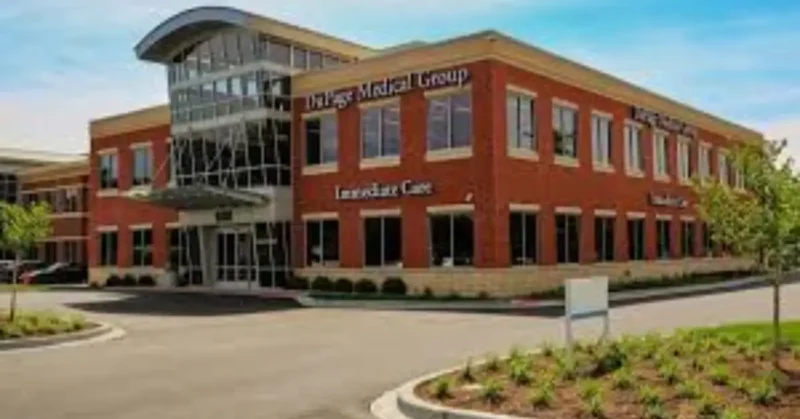Uncover the truth behind Duly Health’s financial trouble—facts, rumors, and what it means for patients, staff, and investors in 2025.
Thank you for reading this post, don't forget to subscribe!In recent years, whispers have circulated that Duly Health and Care (often shortened to “Duly Health”) is under financial stress. Some worry these are merely rumors; others insist there’s truth behind them.
Is Duly Health and Care in Financial Trouble? The Real Facts Behind the Rumors
In this article, we sift through public records, media reports, and industry context to separate fact from speculation.
By the end, you’ll have a clearer sense of Duly Health’s financial position, what pressures it faces, and whether those challenges portend deeper trouble or just a transitional phase.
The Rumor Mill vs. The Reality

Rumors are powerful — particularly when tied to a vital institution like healthcare. For many patients, providers, and employees, the idea of a major healthcare provider faltering triggers alarm.
That’s especially true when that provider, Duly Health, spans dozens of locations, offers specialized services, and has deep integration into Illinois’ healthcare network.
But rumors often oversimplify or exaggerate. To see what’s really going on, we need to dig into public disclosures, industry patterns, and documented moves by Duly Health itself.
Is the organization floundering? Or is it navigating turbulence typical in today’s healthcare climate?
What follows is a fact-based deep dive: why strain may exist, what actions the organization has taken, and what it might do next to steer forward.
Fact 1: Why Financial Strain Exists (The Root Causes)
Let’s begin by examining the structural pressures that appear to be fueling the discussion around Duly Health’s financial stress.
A. Substantial Debt Burden from Private Equity Acquisition
One of the most consistent threads in media and watchdog reports about Duly Health is its heavy leverage tied to its private equity backing. In 2017, DuPage Medical Group (now Duly Health and Care) entered a strategic partnership with Ares Management, a large private equity firm.
The investment was intended to fuel growth, expansion, and increased capabilities. However, along with capital infusion comes financial obligations — and those obligations sometimes carry risks when revenues falter or costs rise.
According to analysis by the Private Equity Stakeholder Project, Duly’s parent entity (Midwest Physician Admin Svcs, LLC) carries a Caa1–PD rating, which denotes “very high default risk” territory.
That rating suggests that the debt load is not merely burdensome but potentially destabilizing under adverse conditions.
Moreover, that same oversight group documented a debt-funded dividend in early 2021, when Duly (via its PE ownership) paid over $200 million to investor owners — effectively borrowing against itself for a payout.
That kind of move can be especially risky when external pressures (like rising operating costs) mount.
These maneuvers, along with a downgrade from Moody’s in 2024, sparked by increased leverage and weaker margins, reinforce that Duly Health’s debt posture is a real and documented stress point.
Thus, unlike rumors that claim “insurmountable debt,” the facts suggest: yes, Duly Health is carrying a heavy debt burden, and that burden amplifies sensitivity to cost increases or revenue softening.
B. Rising Operational Costs and Inflation

Debt is one side of the coin. The other side is the cost to run a healthcare enterprise today — and that side is rising sharply.
Between labor, supplies, pharmaceuticals, regulatory compliance, and increasing demands on infrastructure (EHR systems, telehealth, facility upgrades), many healthcare providers face runaway inflationary pressures in their cost structures.
Staffing, in particular, is a critical line item. Shortages of nurses, technicians, and specialists push wages upward; competition forces providers to bid more aggressively to retain talent.
For Duly Health, which operates many specialist clinics and immediate care centers across a wide geography, that kind of wage inflation must be nontrivial.
Media accounts have noted that rising medical claims and expanding labor expenses were among the drivers of Moody’s decision to downgrade its credit rating in 2024.
So while debt may be the “headline burden,” the everyday reality of cost escalation is just as foundational a cause of financial strain.
C. Industry-Wide Challenges (It’s Not Just Duly Health)
It’s important to situate Duly Health’s challenges within the broader dynamics of the U.S. healthcare industry. The challenges it faces are not unique:
- Many healthcare providers are struggling with shrinking margins due to payer negotiation pressures, rising administrative burdens, and regulatory constraints.
- Private equity–backed healthcare enterprises have been particularly vulnerable; many have collapsed or filed for bankruptcy when leverage proved overwhelming.
- As the Private Equity Stakeholder Project notes, in 2024 alone, at least nine PE-backed healthcare companies filed for bankruptcy, representing nearly 23 % of all large healthcare bankruptcies in the U.S.
- In many cases, PE firms push aggressive debt structures, dividend recapitalizations, and cost-cutting strategies to deliver returns — even at the cost of operational resilience.
Thus, Duly Health is swimming in the same turbulent waters that many other healthcare systems are navigating. Its debt exposure, cost pressures, and operational complexity amplify the risk, but it is not alone.
In short, the financial stress around Duly Health is built on three pillars — debt load, rising operational costs, and industry-wide headwinds — all interacting with one another.
Fact 2: Operational Shifts and Cost-Saving Measures
When an organization faces tightening margins, it must act. Below is what the public record shows Duly Health has done (or is doing) to respond.
A. The Reality of Staff Reductions (Layoffs)
One of the clearest signals that financial pressure exists is workforce reduction. Multiple media outlets, including Crain’s Chicago Business, reported that Duly Health Group has conducted rounds of layoffs in efforts to cut costs.
While the accurate number of affected employees is unclear, the pattern includes multiple rounds — in May and September of the reporting years — along with compensation reductions.
This is consistent with typical cost-control moves when margins tighten and cash flow is under strain.
Layoffs are not inherently proof of insolvency — many organizations adjust staffing to align with evolving volume or strategic priorities — but repeated cutbacks, particularly in a high-stakes sector like healthcare, underline serious financial pressure.
B. Elimination of Non-Core Services
Another way to tighten the belt is to scale back or eliminate services that operate at lower margins or face reimbursement headwinds. In Duly Health’s case, the palliative medicine service line was reportedly shuttered as part of its cost-saving approach.
This move suggests a reorientation toward core, revenue-generating services and a prioritization of more predictable, higher-margin lines. It also indicates that Duly is winnowing offerings to focus on what is sustainable under constrained conditions.
Additionally, Duly decided to cut discretionary employee profit-sharing programs — another signal that when push comes to shove, they prioritize essential operations over perks or non-mission-critical expenditures.
These service-level cuts, while painful, are strategic in nature: reduce exposure, preserve cash, and lean into the organization’s core strengths.
C. Strategic Focus on Core Operational Efficiency

Beyond reactive cuts, Duly Health appears to also be pushing longer-term operational efficiency enhancements. Some signals include:
- Mergers and acquisitions growth strategy: Despite financial headwinds, Duly’s leadership reportedly plans to acquire three or four physician groups in 2025, expanding its footprint and potential economies of scale.
- Streamlining administrative layers: A private-equity partner often encourages simplification of back-office functions, centralization of support services, and technology upgrades to reduce frictional costs.
- Rationalizing facility utilization: By consolidating underutilized locations or shifting services to sites with lower overhead, Duly may improve margins over time.
- Tech-enabled care models: Enhancing telehealth, remote monitoring, and integration with EMR systems (like EPIC MyChart) can improve throughput and reduce redundant costs.
Though these efficiency efforts are common in many healthcare systems, for Duly Health, they are not just optional — they may be vital to maintaining financial viability under its current debt structure and cost pressures.
Thus, the narrative that Duly is simply “overleveraged but otherwise stable” doesn’t capture the full picture: we see active, sometimes aggressive, restructuring moves in real time.
Conclusion: The Strategic Path Beyond the Rumor
So, after examining the underlying causes and operational responses, what is the likely direction for Duly Health? Is collapse imminent — or is this a moment of recalibration?
A. Financial Restructuring and Stabilization Efforts
Given the height of its leverage and the nature of its challenges, it’s likely Duly Health will need to engage in financial restructuring. Potential options include:
- Debt refinancing or extension — negotiating more favorable terms with creditors or extending maturities to relieve short-term cash pressure.
- Distressed debt exchange — offering debt holders alternative securities or equity instead of full repayment, akin to strategies used by PE-backed firms, avoiding formal bankruptcy. (This is not unheard of in the industry today.)
- Equity infusion or recapitalization — bringing in additional capital from new investors or existing owners to shore up balance sheet strength.
- Sale or spin-off of assets — identifying non-core units or real estate holdings to monetize and reduce capital burden.
Such moves are not signs of failure per se, but rather adaptive tools for a leveraged organization in a stressed environment. The same strategies have been employed across healthcare by PE-backed enterprises seeking to stay afloat without filing for bankruptcy.
B. Strategic Partnerships and Growth
Restructuring does not only mean retrenchment. Duly Health may also pursue growth-oriented or collaborative moves to strengthen its position:
- Partnerships with hospital systems — aligning with health systems for referrals, shared services, or risk-based contracts.
- Joint ventures for specialty care lines — partnering with niche providers (e.g., oncology, behavioral health) to share investment and revenue risk.
- Acquisitions for scale — as already signaled in 2025, adding affiliated physician groups to increase bargaining power, expand patient base, and distribute fixed costs.
- Value-based care contracts — moving more toward capitation or bundled payments that favor cost management and population health, enabling predictable revenue streams.
If managed carefully, these moves could help diversify revenue, improve margins, and reduce vulnerability to reimbursement volatility.
C. The Future Role of Private Equity
Throughout this story, private equity involvement is a central actor — and its role will continue to matter.
PE ownership can drive both opportunity and risk. On one hand, PE firms bring financial discipline, capital access, and strategic oversight.
On the other hand, they may impose aggressive return demands, push for short-term cost extraction, or execute dividend recapitalizations that further strain balance sheets.
For Duly Health’s future, some possibilities include:
- A sale to another PE or strategic buyer, allowing investor exit and a fresh capital structure.
- Continued ownership with stricter governance — forcing improved oversight, alignment with long-term operations, and mitigating the risk of aggressive dividend payouts.
- Partial spin-outs or carving off of assets to realign focus and de-leverage parent structure.
The key is whether the PE backers act as patient stewards or extractors. The history of healthcare PE has many examples of both outcomes.
As noted by Moody’s, Duly’s 2024 credit downgrade was explicitly tied to “industrywide challenges, high leverage, and aggressive financial policies.”
That commentary hints at external skepticism about whether the organization and its PE owners can reconcile growth ambitions with prudent capital structure.
FAQs about Duly Health
Q. What is the biggest problem with healthcare today?
The biggest problem with healthcare today is the growing gap between cost and accessibility. While medical technology is advancing rapidly, millions of people still struggle to afford or access quality care.
Rising operational costs, workforce shortages, and administrative complexities make healthcare systems inefficient and expensive. Additionally, fragmented care models often prioritize profits over patients, leading to inconsistent outcomes.
The challenge lies in creating a sustainable system that ensures equitable, patient-centered care for all—without compromising quality or innovation.
Q. What is the meaning of Duly Health?
Duly Health represents the idea of being rightfully committed to better health and exceptional care. The word “Duly” means doing something properly, fittingly, or as expected, reflecting the organization’s philosophy of providing care that is both appropriate and compassionate.
Founded as DuPage Medical Group, Duly Health and Care rebranded in 2021 to emphasize its broader mission—helping people flourish through proactive, personalized, and integrated healthcare.
The name captures a deep sense of responsibility: delivering care that’s not just expected but duly deserved by every patient.
Q. What’s the difference between “duly” and “rightfully”?
Though often used interchangeably, “duly” and “rightfully” have distinct meanings. Duly refers to doing something properly or appropriately, emphasizing timeliness and correctness—like being “duly informed” or “duly noted.”
Rightfully, on the other hand, focuses on justice and entitlement, suggesting moral or legal correctness—such as “rightfully earned” or “rightfully his.”
In short, duly speaks to the way something is done, while rightfully referring to whether something is deserved or justified. Both convey correctness, but from different angles of action and entitlement.
Q. What are the three meanings of health?
Health can be understood in three key dimensions: physical, mental, and social well-being. Physical health refers to the efficient functioning of the body—nutrition, exercise, and absence of disease. Mental health involves emotional stability, resilience, and clarity of thought.
Social health reflects one’s ability to form positive relationships and contribute to community life. Together, these elements go beyond the simple absence of illness—they define health as a dynamic state of balance and vitality that enables individuals to live fulfilling, purposeful lives.
Final Takeaway: Troubled Waters or Course Correction?
So, is Duly Health and Care in financial trouble? The better answer is: Yes — but not irreparably so. The evidence points to real challenges rather than mere rumors. But those challenges also appear to be prompting strategic responses — cost cuts, restructuring, and reinvestment.
- The debt load is significant and was exacerbated by dividend-funded borrowing.
- Operational costs are rising in a sector under stress.
- Media reports and credit rating agencies confirm that Duly’s financial strength is under strain.
- At the same time, Duly is not standing still: it is cutting services, laying off staff, and pursuing partnerships and acquisitions.
It’s not a picture of collapse yet. It’s a picture of a health system under pressure, trying to pivot. Whether Duly Health emerges stronger or succumbs to imbalance will depend on the quality of restructuring, discipline in operations, and alignment with the patient-centric mission.
For patients and stakeholders, the best approach is to watch transparency in financial disclosures, signals of capital restructuring, and how service levels evolve. If new debt deals, asset sales, or external partnerships appear, they will be critical to watch.
Stay Informed. Stay Empowered.
If you found this article helpful, share it with others who care about healthcare transparency. Subscribe to our newsletter to get the latest insights on Duly Health, industry trends, and financial updates that impact patients and providers alike.
Read more articles on Health Tips.
You might like to read:

